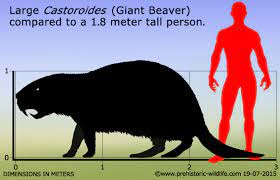1. DAEODON
Chalk up another cool name that's been lost to the technicalities of science. This mammalian megafauna formerly, and fittingly, known as dinohyus (Greek for "terrible pig") has now reverted back to an earlier moniker, the far less awesome daeodon.
Tipping the scales at a full ton, this Miocene pig was roughly the size and weight of a modern rhinoceros or hippopotamus, with a broad, flat, warthog-like face complete with "warts" (actually fleshy wattles supported by bone).
As you might already have guessed, daeodon was closely related to the slightly earlier (and slightly smaller) entelodon, also known as the "killer pig." Both of these opportunistic genera are giant, prehistoric porkers, the former native to North America and the latter to Eurasia.
Daeodon was also equipped with heavy, bone-crushing jaws, another classic scavenging adaptation similar to that of roughly contemporary bone-crushing canids, and it's sheer one-ton bulk would have intimidated smaller predators from trying to protect their newly killed prey.
2. MEGALANIA
Aside from crocodiles, very few prehistoric reptiles after the age of dinosaurs achieved enormous sizes--one notable exception being Megalania, also known as the Giant Monitor Lizard.
Depending on whose reconstruction you believe, Megalania measured anywhere from 12 to 25 feet from head to tail and weighed in the neighborhood of 500 to 4,000 pounds--a wide discrepancy, to be sure, but one that would still put it in a heftier weight class than the largest lizard alive today, the Komodo Dragon (a relative lightweight at "only" 150 pounds).
However, modern paleontologists believe that the Giant Monitor Lizard should properly be classified under the same genus umbrella as modern monitor lizards, Varanus. The result is that professionals refer to this giant lizard as Varanus priscus, leaving it to the public to wield the "nickname" Megalania.
3.GLYPTODON
Glyptodon was essentially a dinosaur-sized armadillo, with a huge, round, armored carapace, stubby, turtle-like legs, and a blunt head on a short neck. As many commentators have pointed out, this Pleistocene mammal looked a bit like a Volkswagen Beetle, and tucked up under its shell it would have been virtually immune to predation (unless an enterprising meat-eater figured out a way to flip Glyptodon onto its back and dig into its soft belly). The only thing Glyptodon lacked was a clubbed or spiked tail, a feature evolved by its close relative Doedicurus (not to mention the dinosaurs that most resembled it, and which lived tens of millions of years earlier, Ankylosaurus and Stegosaurus).
Discovered in the early 19th century, the type fossil of Glyptodon was initially mistaken for a specimen of Megatherium, aka the Giant Sloth, until one enterprising naturalist (braving howls of laughter, no doubt) thought to compare the bones with those of a modern armadillo.
4.GIANT BEAVER
It sounds like the punchline to a prehistoric joke: an eight-foot-long, 200-pound beaver with six-inch-long incisors, a narrow tail, and long, shaggy hair. But Castoroides, also known as the Giant Beaver, really existed, and it fit right in with the other plus-sized megafauna of its late Pliocene and Pleistocene ecosystem. Like modern beavers, the Giant Beaver probably led a partially aquatic lifestyle--especially since it was too big and bulky to move about sleekly on land, where it would have made a tasty meal for a hungry Saber-Tooth Tiger. (By the way, other than both being mammals, the Giant Beaver was completely unrelated to the beaver-like Castorocauda, which lived during the late Jurassic period.)
The question everyone asks is: did the Giant Beaver build equally giant dams? Sadly, if it did, no evidence of these gigantic construction projects has been preserved into modern times, though some enthusiasts point to a four-foot-high dam in Ohio (which may well have been made by another animal, or be a natural formation). Like the other mammalian megafauna of the last Ice Age, the extinction of the Giant Beaver was hastened by the early human settlers of North America, who may have valued this shaggy beast for its fur as well as its meat.
THE PART 2 OF THIS WILL BE PUBLISHED SOON.........🌝






0 Comments